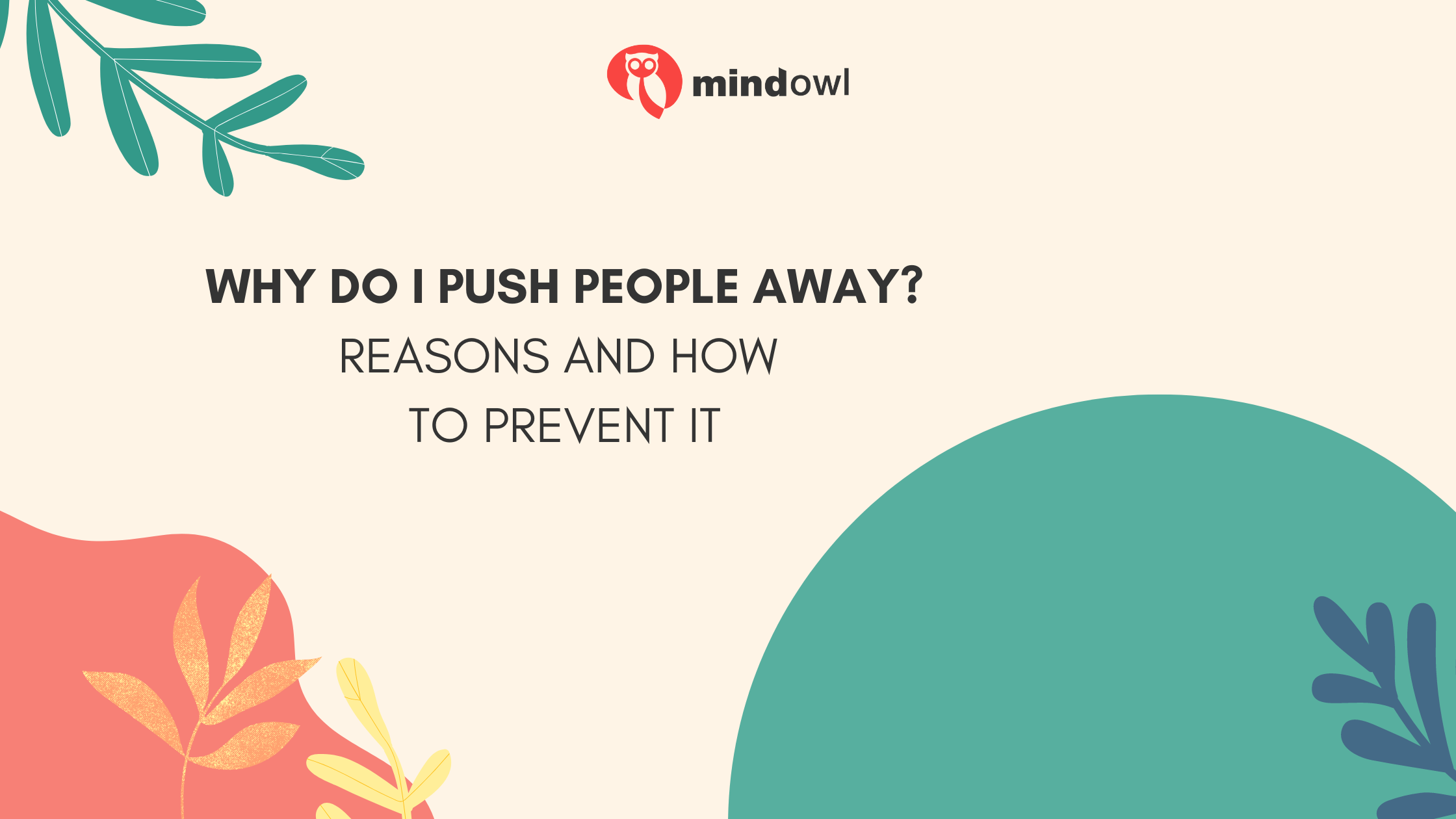Have you ever found yourself pushing loved ones away, even when deep down, you didn’t want to? Many of us have been there. It’s like a part of you wants to keep people close, but another part fears what might happen if you do.
Pushing people away is often a defence mechanism—a way we try to protect ourselves from getting hurt.
One important fact here is that this habit doesn’t just pop up out of nowhere. It can stem from fear of intimacy or having trust issues. This article aims to unravel the mystery behind why we push others away and offers steps on how we can stop doing it—to let love and friendships into our lives without fear.
Ready for some answers? Keep reading!
Understanding the Psychology Behind Pushing People Away
People push others away due to fear of intimacy, attachment issues, and low self-esteem. These psychological factors contribute to a tendency to distance themselves from close relationships.
Fear of intimacy
Fear of intimacy is a common reason that leads you to push loved ones away. This fear makes opening up and sharing your feelings with others feel dangerous. You might worry about getting too close because it feels safer to maintain a distance.
This way, the risk of being hurt or rejected seems lower.
Fear of intimacy results in avoiding closeness, making physical and emotional distance a defence mechanism.
This avoidance often shows through short conversations and not paying attention to what others need or want. Letting people into your life becomes hard when every effort towards closings feels like inviting pain.
So, keeping everyone at arm’s length preserves your peace but costs you meaningful connections.

Attachment issues
Attachment issues often start early in life. The way a child connects with their parents or main caregivers can shape their future relationships. This connection is key to feeling safe and loved.
If this bond is shaky, it may lead to problems with trusting others later on. People with attachment problems might see the world as a more threatening place. They might struggle to open up or fully trust partners and friends.
These troubles are linked to mental health worries like anxiety and depression. Understanding your attachment style helps in tackling these fears of intimacy and rejection that push people away.
Knowing about these patterns can be the first step towards building healthier connections. It’s about learning how not to let past hurts control present relationships.
Low self-esteem or self-confidence
Low self-esteem is like a shadow that follows you everywhere, making it hard to believe in yourself. People with this issue often think they’re not good enough. This doubt can stop them from getting close to others or staying in love.
They might push loved ones away before getting hurt. Anxiety and sadness are common feelings that feed into low self-esteem. These mental health challenges make the problem bigger.
Feeling unsure about yourself makes forming healthy bonds tough. You may avoid deep talks or find reasons why someone shouldn’t be with you. It’s a way of protecting your heart but also keeps joy at bay.
Trying to boost your confidence is key – small steps count! Talking about your fears with friends, family, or a professional can start changing this pattern of pushing people away because of low self-esteem or no confidence at all.
Common Signs of Pushing People Away
Trouble trusting others
Fear of intimacy and issues from our childhood can lead us to trouble trusting others. We might have learned that getting close hurts, thanks to early letdowns or rejections. This fear acts like a wall, keeping people out as a defence mechanism.
It’s not just about being scared of romance or deep friendships; it also shows up in everyday interactions, making small talk feel like a big ask.
Low self-esteem plays into this too. If we don’t see much value in ourselves, it’s hard to believe anyone else will either. That lack of confidence feeds the cycle, making us push everyone away as a protection against expected hurt.
Trusting doesn’t come easy if you’re always on guard for betrayal or expecting to be seen as less than. Past wounds—from family drama to broken hearts—make opening up seem risky at best and foolish at worst.
You feel like a burden
Believing you’re a load to others can deeply affect your mind. It’s a feeling that might push you away even more from those around you. The thought of being a nuisance makes it hard to open up, leaving you stuck in a cycle of solitude and sadness.
Feeling like this often sends people seeking help from professionals, such as therapists, who understand these complex emotions.
Feeling like a burden is a common reason people seek therapy.
The idea that all relationships are doomed can also make one feel they are just adding trouble rather than joy to others’ lives. This belief may stem from past experiences or fear of rejection, leading one to keep pushing loved ones away.
Understanding this pattern is the first step towards breaking it and building healthier connections with those around us.
You’re drained
Feeling drained often points to the fact that you’re pushing people away. This can lead to feeling very tired, both mind and body. Building healthier bonds with those around you might help lessen this exhaustion.
It’s a sign that something needs to change in how you connect with others.
Recognising these signs early on is very important. Once you see them, you can start making changes like practising self-kindness or seeking support from a therapist. These steps are essential for your mental well-being and for forming stronger, more meaningful relationships without draining your energy.
Strategies to Stop Pushing People Away
Take small steps to build trust and intimacy. Be kind to yourself and consider seeking guidance from a therapist. For more insights, read the full article.
Take it slow
Rushing things can make it harder to address intimacy issues and avoidance. Taking steps at your own pace can play a big part in forming solid, healthy relationships. It allows you to become comfortable with someone without the pressure of moving too quickly.
This approach gives you space to understand and tackle fears of getting hurt.
Start by setting small goals for opening up or sharing more with others. If feeling close scares you because past trauma or attachment styles have made closeness equal pain, slow progress can help heal these wounds.
Every little success builds trust in yourself and others, showing that not everyone will let you down or push love away. Slowly, this method helps change patterns where pushing people away seemed like the only option for self-preservation against emotional pain.
Practice self-compassion
Self-compassion is vital for changing the pattern of pushing people away. It involves being kind to yourself and acknowledging that everyone makes mistakes. By prioritising self-care, individuals with low self-esteem can gradually learn to let others in and build healthier relationships.
Being compassionate towards oneself also means recognising the need for emotional support and seeking help from therapists or trusted individuals when necessary.
Incorporating self-compassion into daily life helps in navigating attachment issues and fear of intimacy, which are common reasons for pushing people away. Taking small steps towards self-compassion leads to a more secure sense of self-worth and, ultimately, fosters more meaningful connections with others.
Remembering that everyone experiences challenges can alleviate feelings of isolation and promote a greater willingness to open up to those around you.
Talk with a therapist
Talking with a therapist can effectively address fear of intimacy, attachment issues, and low self-esteem. Therapists provide professional guidance to navigate attachment styles and build self-confidence in relationships.
Seeking help from a therapist helps understand the root causes of fear of intimacy and assists in working through intimacy avoidance patterns.
Conclusion
Understanding why people are pushed away is key to building healthier, closer relationships. It can be a defence mechanism to avoid getting hurt in intimate relationships but recognising and addressing these fears is crucial.
Taking it slow, practising self-compassion, and seeking therapy are effective ways to break this pattern. By identifying and working through attachment issues or low self-esteem, one can move towards forming more fulfilling connections with others.
Seeking therapy can be instrumental in addressing intimacy avoidance due to the fear of getting hurt without letting people around you down. This process might require time and effort but taking small steps towards change is an important first move.
Opening up about your struggles may lead you to form deeper connections with those around you.
MindOwl Founder – My own struggles in life have led me to this path of understanding the human condition. I graduated with a bachelor’s degree in philosophy before completing a master’s degree in psychology at Regent’s University London. I then completed a postgraduate diploma in philosophical counselling before being trained in ACT (Acceptance and commitment therapy).
I’ve spent the last eight years studying the encounter of meditative practices with modern psychology.

